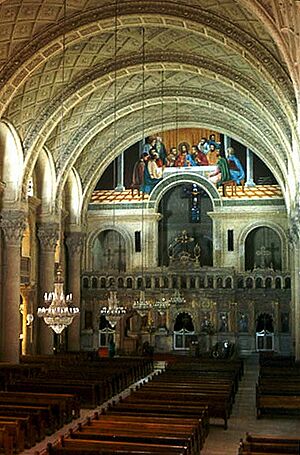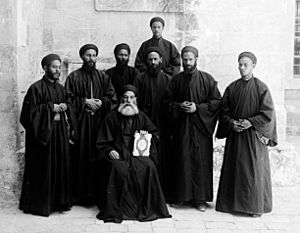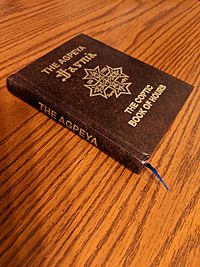Coptic Orthodox Church facts for kids
Quick facts for kids Coptic Orthodox Patriarchate of Alexandria |
|
|---|---|
| ϯⲉⲕ̀ⲕⲗⲏⲥⲓⲁ ⲛ̀ⲣⲉⲙⲛ̀ⲭⲏⲙⲓ ⲛ̀ⲟⲣⲑⲟⲇⲟⲝⲟⲥ (Coptic) الكنيسة القبطية الأرثوذكسية (Arabic) |
|
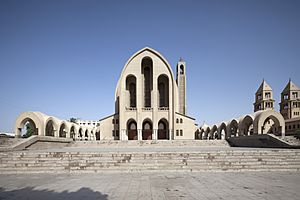
Saint Mark's Coptic Orthodox Cathedral, Cairo, Egypt
|
|
| Type | Autocephaly |
| Classification | Christian |
| Orientation | Oriental Orthodox |
| Scripture | Septuagint, New Testament, Coptic versions |
| Theology | Oriental Orthodox theology |
| Polity | Episcopal |
| Governance | Holy Synod of the Coptic Orthodox Church |
| Pope | Tawadros II |
| Region | Egypt, Libya, Sudan, Middle East, and diaspora |
| Language | Coptic, Greek, Arabic, Dialectal Arabic, Tamazight (minority) |
| Liturgy | Coptic Rite |
| Headquarters | Saint Mark's Coptic Orthodox Cathedral, Cairo, Egypt |
| Founder | St. Mark the Evangelist (traditional) |
| Origin | 42 A.D Alexandria, Egypt |
| Separations | Coptic Catholic Church (1895) British Orthodox Church (2015) |
| Members | 10 million |
| Other name(s) | Coptic Church Coptic Orthodox Church |
| Logo | |
The Coptic Orthodox Church is one of the oldest Christian churches in the world. It is based in Egypt and is a type of Oriental Orthodox Christian church. The word "Coptic" comes from an old word for "Egyptian."
The leader of the church is the Pope of Alexandria. He is seen as the successor to Saint Mark, who is believed to have founded the church around the year 42 AD. The main headquarters is Saint Mark's Coptic Orthodox Cathedral in Cairo, Egypt.
Coptic Christians are the largest Christian group in the Middle East. In Egypt, there are about 10 million members, making them the country's largest minority group. The church uses its own special traditions for prayers and services, known as the Coptic Rite.
History of the Coptic Church
The Coptic Church has a long and rich history that is deeply connected to Egypt.
How the Church Began
According to tradition, the Coptic Church was started by Saint Mark the Evangelist in about 42 AD. Saint Mark was one of the writers of the Gospels in the New Testament.
The church quickly grew in Egypt. It started the Catechetical School of Alexandria, which was one of the first Christian schools in the world. This school became a famous center for learning about Christianity and the Bible.
The Coptic Language
The Coptic language is the ancient language of Egypt. It is written using an alphabet that is mostly based on Greek letters. After the Arab conquest of Egypt, the use of Coptic in daily life was discouraged.
However, the church continued to use the Coptic language in its services. This helped to preserve the language for centuries. Today, Coptic is still used in church hymns and prayers, often alongside Arabic, which is the main language spoken in Egypt.
Important Church Councils
In the early centuries of Christianity, church leaders held meetings called councils to discuss important beliefs. The Coptic Church played a big role in these meetings.
The Council of Nicaea (325 AD)
This council was held to discuss the teachings of a priest named Arius, who had different ideas about Jesus. The council wrote the Nicene Creed, a statement of faith that many Christians still use today.
The Council of Constantinople (381 AD)
This meeting added to the Nicene Creed. It confirmed the Christian belief in the Holy Spirit. The Coptic Pope Timothy I of Alexandria led this council.
The Council of Ephesus (431 AD)

This council dealt with a debate about Mary, the mother of Jesus. The church leaders confirmed that she should be called "Mother of God" (Theotokos). This was an important decision that supported the church's understanding of Jesus.
The Council of Chalcedon (451 AD)
This council caused a major split in the Christian world. There was a disagreement about how to describe Jesus as being both divine and human. The Coptic Church, along with other Oriental Orthodox Churches, did not agree with the council's final decision.
This disagreement led to the Coptic Church separating from the churches that would later become the Roman Catholic and Eastern Orthodox churches. From this point on, the Egyptian church had its own leader, the Coptic Pope.
From the Arab Conquest to Modern Times
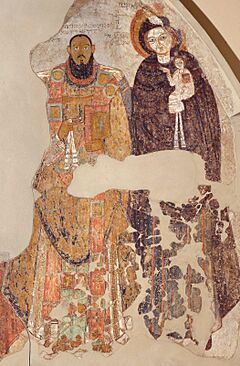
In 639 AD, Muslim armies from Arabia conquered Egypt. Life for Christians changed under the new rulers. Over many centuries, Egypt slowly changed from a mostly Christian country to a mostly Muslim one. In the 12th century, the Coptic Pope moved the church's headquarters from Alexandria to Cairo.
During the 19th century, life for Copts began to improve. They were given more rights and started to serve in the Egyptian army. Pope Cyril IV opened modern schools, including the first school for girls in Egypt.
The Church in the 20th and 21st Centuries
In the 20th century, the Coptic Church granted independence to other churches that it had historically led. The Ethiopian Orthodox Tewahedo Church became independent in 1959, and the Eritrean Orthodox Tewahedo Church followed in 1998.
Coptic Christians have faced challenges and discrimination in recent years. After the 2011 Egyptian Revolution, there was an increase in difficulties for the community. In 2015, 21 Coptic men working in Libya were tragically killed by extremists. In 2023, Pope Francis of the Catholic Church announced that these 21 men would be honored as martyrs by the Catholic Church as well.
Despite these hardships, the church continues to grow. Under Pope Shenouda III (1971–2012), the church expanded its services, opening hospitals, schools, and community centers. The current leader, Pope Tawadros II of Alexandria, continues to work with the Egyptian government and other Christian churches.
Beliefs and Practices
Coptic Christians have unique traditions for worship and daily life.
Prayer and Worship
Members of the Coptic Church pray seven times a day. This practice is inspired by a verse in the Bible (Psalm 119:164). They use a prayer book called the Agpeya. Before praying, they wash their hands and face and remove their shoes as a sign of respect before God. Coptic churches are built to face east, the direction of the rising sun, which symbolizes the return of Christ.
Fasting
Fasting is a very important practice in the Coptic Church. When fasting, people do not eat any animal products, including meat, eggs, and dairy. Copts fast on every Wednesday and Friday to remember the betrayal and crucifixion of Jesus.
They also have longer fasting periods before major holidays like Christmas and Easter. In total, Copts fast for about two-thirds of the year.
Feasts and Holidays
The Coptic Church celebrates seven major feasts:
- Annunciation
- Christmas (usually on January 7th)
- Epiphany
- Palm Sunday
- Easter
- Ascension
- Pentecost
Christmas has been a national holiday in Egypt since 2003.
The Coptic Church Today
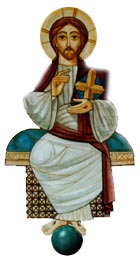
It is estimated that there are about 10 million Coptic Orthodox Christians in Egypt. This makes them the largest Christian community in the Arab world.
There are also many Coptic Christians living outside of Egypt in countries like the United States, Canada, and Australia. These communities are known as the Coptic diaspora. The church also has a presence in other parts of Africa, especially in Sudan.
The Coptic Orthodox Church is led by the Pope of Alexandria and the Holy Synod, which is a council of bishops. The synod helps govern the church and makes important decisions about its future.
See also
 In Spanish: Iglesia copta ortodoxa para niños
In Spanish: Iglesia copta ortodoxa para niños
- Copts
- List of Coptic saints
- Coptic architecture
- Oriental Orthodox Churches
- Christianity in Africa
- Christianity in the Middle East
- Arab Christians


